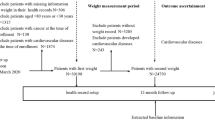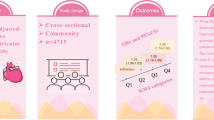Abstract
Obesity with increased high-sensitive cardiac troponin T (hs-cTnT) has been reported to be more likely to progress cardiovascular disease (CVD) events, which suggests that hs-cTnT may identify a “malignant” phenotype of obesity. We classified 3513 hypertensive patients from the Japan Morning Surge-Home Blood Pressure (J-HOP) study into groups based on body mass index (BMI) (normal weight: <25 kg/m2, overweight: 25–29.9 kg/m2, obesity: ≥30 kg/m2) and elevations in biomarker levels (hs-cTnT ≥3 ng/mL: 51.3%, 54.9%, 53.3%, and N-terminal pro-brain natriuretic peptide [NT-ProBNP] ≥55 pg/mL: 51.1%, 40.7%, 36.0% in each BMI category). We evaluated the independent and combined associations of BMI and each hs-cTnT/NT-proBNP or both with CVD events (fatal and nonfatal coronary artery disease, stroke, and hospitalized heart failure). During the mean 6.4 ± 3.9-year follow-up, 232 CVD events occurred. Obesity with elevated hs-cTnT was associated with a risk of CVD events compared to normal weight without elevated hs-cTnT (hazard ratio 3.22, 95% confidence interval: 1.83–5.68). A similar pattern of results was also observed across the status of obesity and elevated NT-proBNP. There was a significant interaction between hs-cTnT and CVD events according to the obesity status (p = 0.039), while this association was marginal in NT-proBNP (p = 0.060). The magnitude of the mediation of hs-cTnT for the association between obesity and CVD risk was 41.2%, and that for NT-proBNP was 8.1%. In this Japanese hypertensive population, the elevation of hs-cTnT identified obese patients at particularly high risk for developing CVD events, suggesting that hs-cTnT may identify a ‘malignant’ phenotype of obesity.

This is a preview of subscription content, access via your institution
Access options
Subscribe to this journal
Receive 12 print issues and online access
$259.00 per year
only $21.58 per issue
Buy this article
- Purchase on Springer Link
- Instant access to full article PDF
Prices may be subject to local taxes which are calculated during checkout


Similar content being viewed by others
References
NCD Risk Factor Collaboration (NCD-RisC). Trends in adult body-mass index in 200 countries from 1975 to 2014: a pooled analysis of 1698 population-based measurement studies with 19·2 million participants. Lancet. 2016;387:1377–96.
Upadhyay J, Farr O, Perakakis N, Ghaly W, Mantzoros C. Obesity as a disease. Med Clin North Am. 2018;102:13–33.
Ortega FB, Lavie CJ, Blair SN. Obesity and cardiovascular disease. Circ Res. 2016;118:1752–70.
Koliaki C, Liatis S, Kokkinos A. Obesity and cardiovascular disease: revisiting an old relationship. Metabolism. 2019;92:98–107.
Lavie CJ, Milani RV, Ventura HO. Obesity and cardiovascular disease: risk factor, paradox, and impact of weight loss. J Am Coll Cardiol. 2009;53:1925–32.
Hamer M, Stamatakis E. Metabolically healthy obesity and risk of all-cause and cardiovascular disease mortality. J Clin Endocrinol Metab. 2012;97:2482–8.
Stefan N, Häring HU, Hu FB, Schulze MB. Metabolically healthy obesity: epidemiology, mechanisms, and clinical implications. Lancet Diabetes Endocrinol. 2013;1:152–62.
Welsh P, Preiss D, Hayward C, Shah ASV, McAllister D, Briggs A, et al. Cardiac troponin T and troponin I in the general population. Circulation. 2019;139:2754–64.
Huang J, Liu M, Su E, Yu P, Jiang H, Zhao J, et al. Elevated circulating high-sensitive cardiac troponin T and cardiac remodeling in obesity. BMC Cardiovasc Disord. 2021;21:620.
Boudina S, Sena S, O’Neill BT, Tathireddy P, Young ME, Abel ED. Reduced mitochondrial oxidative capacity and increased mitochondrial uncoupling impair myocardial energetics in obesity. Circulation. 2005;112:2686–95.
Abel ED, O’Shea KM, Ramasamy R. Insulin resistance: metabolic mechanisms and consequences in the heart. Arterioscler Thromb Vasc Biol. 2012;32:2068–76.
Lopaschuk GD, Folmes CD, Stanley WC. Cardiac energy metabolism in obesity. Circ Res. 2007;101:335–47.
Park SK, Ryoo JH, Oh CM, Choi JM, Kang JG, Lee JH, et al. Effect of overweight and obesity (defined by Asian-Specific Cutoff Criteria) on left ventricular diastolic function and structure in a general Korean population. Circ J. 2016;80:2489–95.
Ndumele CE, Coresh J, Lazo M, Hoogeveen RC, Blumenthal RS, Folsom AR, et al. Obesity, subclinical myocardial injury, and incident heart failure. JACC Heart Fail. 2014;2:600–7.
WHO Expert Consultation. Appropriate body-mass index for Asian populations and its implications for policy and intervention strategies. Lancet 2004;363:157–63.
Pan WH, Yeh WT. How to define obesity? Evidence-based multiple action points for public awareness, screening, and treatment: an extension of Asian-Pacific. Asia Pac J Clin Nutr. 2008;17:370–4.
Brouwers FP, van Gilst WH, Damman K, van den Berg MP, Gansevoort RT, Bakker SJ, et al. Clinical risk stratification optimizes value of biomarkers to predict new-onset heart failure in a community based cohort. Circ Heart Fail. 2014;7:723–31.
Chow SL, Maisel AS, Anand I, Bozkurt B, de Boer RA, Felker GM, et al. Role of biomarkers for the prevention, assessment, and management of heart failure: a scientific statement from the American Heart Association. Circulation. 2017;135:e1054–e1091.
Hoshide S, Yano Y, Haimoto H, Yamagiwa K, Uchiba K, Nagasaka S, et al. Morning and evening home blood pressure and risks of incident stroke and coronary artery disease in the Japanese general practice population: the Japan Morning Surge-Home Blood Pressure study. Hypertension. 2016;68:54–61.
WHO. Obesity: preventing and managing the global epidemic. Report of a WHO consultation. WHO Tech Rep Ser; 2000. p. 1–253.
Anwar YA, Giacco S, McCabe EJ, Tendler BE, White WB. Evaluation of the efficacy of the Omron HEM-737 IntelliSense device for use on adults according to the recommendations of the Association for the Advancement of Medical Instrumentation. Blood Press Monit. 1998;3:261–5.
de Lemos JA, Drazner MH, Omland T, Ayers CR, Khera A, Rohatgi A, et al. Association of troponin T detected with a highly sensitive assay and cardiac structure and mortality risk in the general population. JAMA. 2010;304:2503–12.
Doi Y, Ninomiya T, Hata J, Hirakawa Y, Mukai N, Ikeda F, et al. N-terminal pro-brain natriuretic peptide and risk of cardiovascular events in a Japanese community: the Hisayama study. Arterioscler Thromb Vasc Biol. 2011;31:2997–3003.
Karelis AD, St-Pierre DH, Conus F, Rabasa-Lhoret R, Poehlman ET. Metabolic and body composition factors in subgroups of obesity: what do we know? J Clin Endocrinol Metab. 2004;89:2569–75.
Karelis AD. Metabolically healthy but obese individuals. Lancet. 2008;372:1281–3.
Eckel N, Li Y, Kuxhaus O, Stefan N, Hu FB, Schulze MB. Transition from metabolic healthy to unhealthy phenotypes and association with cardiovascular disease risk across BMI categories in 90 257 women (the Nurses’ Health Study): 30-year follow-up from a prospective cohort study. Lancet Diabetes Endocrinol. 2018;6:714–24.
Bell JA, Kivimaki M, Hamer M. Metabolically healthy obesity and risk of incident type 2 diabetes: a meta-analysis of prospective cohort studies. Obes Rev. 2014;15:504–15.
Arnlöv J, Ingelsson E, Sundström J, Lind L. Impact of body mass index and the metabolic syndrome on the risk of cardiovascular disease and death in middle-aged men. Circulation. 2010;121:230–6.
Flint AJ, Hu FB, Glynn RJ, Caspard H, Manson JE, Willett WC, et al. Excess weight and the risk of incident coronary heart disease among men and women. Obesity (Silver Spring). 2010;18:377–83.
Alpert MA. Obesity cardiomyopathy: pathophysiology and evolution of the clinical syndrome. Am J Med Sci. 2001;321:225–36.
Marchio P, Guerra-Ojeda S, Vila JM, Aldasoro M, Victor VM, Mauricio MD. Targeting early atherosclerosis: a focus on oxidative stress and inflammation. Oxid Med Cell Longev. 2019;1:8563845.
Xu H, Barnes GT, Yang Q, Tan G, Yang D, Chou CJ, et al. Chronic inflammation in fat plays a crucial role in the development of obesity-related insulin resistance. J Clin Invest. 2003;112:1821–30.
Olefsky JM, Glass CK. Macrophages, inflammation, and insulin resistance. Annu Rev Physiol. 2010;72:219–46.
Reilly SM, Saltiel AR. Adapting to obesity with adipose tissue inflammation. Nat Rev Endocrinol. 2017;13:633–43.
Suthahar N, Meems LMG, Groothof D, Bakker SJL, Gansevoort RT, van Veldhuisen DJ, et al. Relationship between body mass index, cardiovascular biomarkers, and incident heart failure. Eur J Heart Fail. 2021;23:396–402.
Wang TJ, Larson MG, Levy D, Benjamin EJ, Leip EP, Wilson PW, et al. Impact of obesity on plasma natriuretic peptide levels. Circulation. 2004;109:594–600.
Bayes-Genis A, Lloyd-Jones DM, van Kimmenade RR, Lainchbury JG, Richards AM, Ordoñez-Llanos J, et al. Effect of body mass index on diagnostic and prognostic usefulness of amino-terminal pro-brain natriuretic peptide in patients with acute dyspnea. Arch Intern Med. 2007;167:400–47.
Parcha V, Patel N, Kalra R, Suri SS, Arora G, Wang TJ, et al. Obesity and Serial NT-proBNP levels in guided medical therapy for heart failure with reduced ejection fraction: insights from the GUIDE-IT trial. J Am Heart Assoc. 2021;10:e018689.
Funding
The 21st Century Center of Excellence Project run by Japan’s Ministry of Education, Culture, Sports, Science, and Technology; a grant from the Foundation for Development of the Community (Tochigi); a grant from Omron Healthcare Co., Ltd.; a Grant-in-Aid for Scientific Research (B) (21390247) from the Ministry of Education, Culture, Sports, Science and Technology (MEXT) of Japan, 2009 to 2013; and funds from the MEXT-Supported Program for the Strategic Research Foundation at Private Universities, 2011 to 2015, Cooperative Basic and Clinical Research on Circadian Medicine (S1101022) to K. Kario. Funding sponsors had no role in the design or conduct of the study, the collection, management, analysis, or interpretation of the data, the preparation of the article, or the decision to submit the article for publication.
Author information
Authors and Affiliations
Corresponding author
Ethics declarations
Conflict of interest
KK has received research funding from Omron Healthcare Co, Fukuda Denshi, and A&D Co. None of the other authors have any conflicts of interest to disclose.
Additional information
Publisher’s note Springer Nature remains neutral with regard to jurisdictional claims in published maps and institutional affiliations.
Supplementary information
Rights and permissions
Springer Nature or its licensor (e.g. a society or other partner) holds exclusive rights to this article under a publishing agreement with the author(s) or other rightsholder(s); author self-archiving of the accepted manuscript version of this article is solely governed by the terms of such publishing agreement and applicable law.
About this article
Cite this article
Watanabe, H., Hoshide, S., Kanegae, H. et al. Prognosis of a malignant phenotype of obesity defined by a cardiac biomarker in hypertension: the Japan Morning Surge-Home Blood Pressure study. Hypertens Res 47, 487–495 (2024). https://doi.org/10.1038/s41440-023-01468-8
Received:
Revised:
Accepted:
Published:
Issue Date:
DOI: https://doi.org/10.1038/s41440-023-01468-8
Keywords
This article is cited by
-
Will obesity break your heart - cardiac biomarkers in the Japan Morning Surge-Home Blood Pressure study
Hypertension Research (2024)



